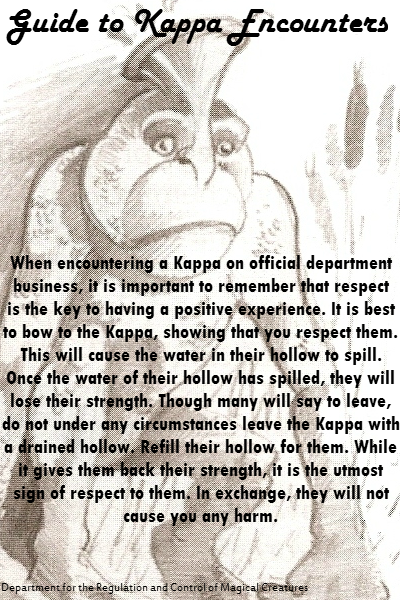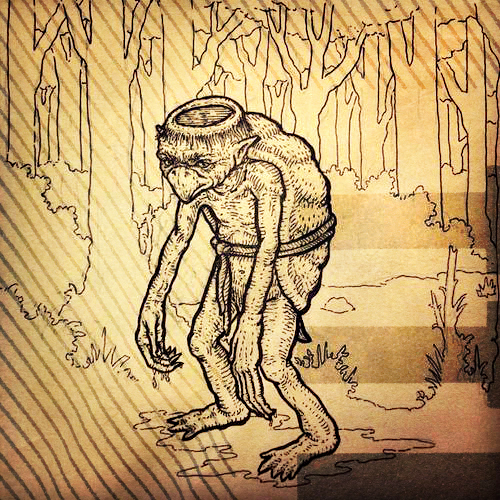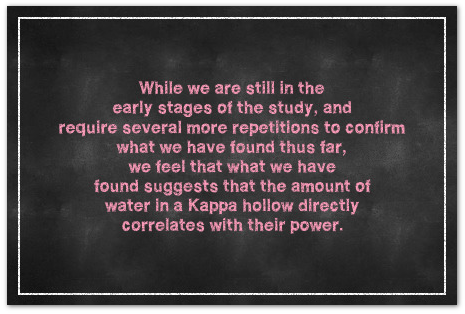Announcements
Welcome to Care of Magical Creatures 501!
This is the fourth year of Care of Magical Creatures.
If you have any questions about the course, please contact Professor Aspen, who has kindly accepted to be in charge of it while a new professor is appointed by the Ministry of Magic.
Lesson 3) The Deadly Sea Cucumber
The Deadly Sea Cucumber
Welcome students to another lesson! It is just myself today, though Professor Cattercorn is hard at work with the lesson for next week. We will investigate a water demon I know you have covered in Defense Against the Dark Arts already: the kappa. Though you will never truly “care” for a kappa, it is a creature that magizoologists run into often on treks and expeditions, so it is important you understand the intricacies when encountering this creature, and the most acceptable approach of handling when it comes to the Department for the Regulation and Control of Magical Creatures.
Kappas: The Water Monkeys
Physical Description and Reproduction

Kappas are a Japanese water demon that are classified by the DRCMC as XXXX Beasts. As you should recall, this means that they are considered “dangerous, requiring specialist knowledge, and/or a skilled wizard may handle.” They are not a creature to be taken lightly, and should be handled with extreme caution, especially once we consider why they are called demons. They are native to bodies of water in Japan, and thus their name comes from the Japanese words for “river” and “child”.
As you learned during your third year of Defense Against the Dark Arts, kappas are described to be scaly water monkeys, having webbed hands, beaked mouths, and a large hollow bowl on the top of their head. This hollow bowl is filled with water, which gives the kappa its strength. We will discuss this more in-depth later on in the lesson. They average the size of Bornean orangutans, with an average height and weight of 3.9-4.6 feet and 110-220 pounds, respectively. This variation in size accounts for gender and age differences. We call this sexual dimorphism, meaning that males and females are different sizes. Male kappas are significantly larger than female kappas. Whereas a female kappa may stand closer to the lower end of 3.9 feet tall, the male kappa may stand closer to the higher end of 4.6 feet tall. Being just about five feet tall myself, coming across a kappa that is about my height would be intimidating!
Kappas do mate, however, it is incredibly rare! Kappas can live hundreds of years, since the only way they can die is if their hollow is empty for an extended period of time. Therefore,they don’t mate very often in their lifetime. They would rather spend their time on other activities, like those detailed in the next section. A male kappa and female kappa will come together, and the decision will be made by the both of them to mate. The process typically begins with an offering on the male’s part, and can range from a dead animal to a kidnapped child. Males will only give between three and five offerings in their lifetime, usually when they feel they are in danger. Kappas are intelligent creatures, and if they detect an influx of individuals, like during camping season, they will fear for their safety and home. The female will either accept the offering, or turn the other cheek and ignore it. Should she accept it, the mating process will continue. Should she ignore it, the male will continue about his business and leave the offering, now turned into a peace offering, to ensure the pair is on good terms. Like males, females will only accept between three and five offerings in their lifetime.
Once the offering has been accepted, the pair will plot a kidnapping. As awful as this is, they will kidnap and feed on a young human child together. This will constitute a union in their eyes, similar to a marriage. The pair will then proceed to mate. They have a gestational period of about three months, but this can vary depending on how often the female loses her power, among other factors. Kappas will only have one offspring per mating. When the offspring is born, it will already be about two feet tall. The magic that goes into creating these creatures is amazing. Whereas Nogtails must stay in the womb longer to develop their magic, the magic in kappas actually increases the rate of development. After birth, a young kappa takes another three to six months to reach their full potential. Though they are still growing, they do not live with their parents. After the mating process, the male kappa returns to his space, and after giving birth the female kappa will relocate and allow her offspring to keep the current space as their own.
Why Are They Considered A Demon? How Do I Protect Myself?
Kappas are considered demons because of their diet: human blood. They obtain their food source through strangling humans that unknowingly wander into their domain. In history, they have also been documented to kidnap animals and young children. While you wouldn’t think they would be able to with webbed hands, as long as there is water in their hollow, their strength is unmatched. This is precisely why it is important to understand the nature of a kappa if you are to get away from them before meeting such an awful fate. I say this not to make you feel alarmed, but to prepare you, because the DRCMC not only encounters kappas on expeditions, but actually conducts quite a bit of research on them. We will discuss that research later on in the lesson, but I wanted to stress the importance of understanding this creature.
To prevent such a fate, there are two methods you can use. The more practical, and widely believed, is to show your respects to the kappa. These creatures really put an emphasis on politeness. By bowing to a kappa upon meeting it, you are showing them that respect. After performing a deep bow, they will bow to you in return. Upon bowing, the water in their hollow will spill out, causing them to lose all of their strength. You are then free to continue about your business quickly or leave, as they will regain their strength once their hollow is refilled. Instead of fleeing, you can also choose to refill the hollow for the kappa. This will create an eternal protection for you from the kappa. Refilling their hollow is seen as one of the most polite acts one could do for a kappa, so they will not harm you if you do this. I personally recommend this. I refilled the hollow of a kappa while in Japan searching for a hidden Chinese Fireball breeding facility (It was presumed they thought they would slide under the radar by breeding dragons in a country that has no native dragons, but that is a story of another occasion), and have since been very friendly with kappas when I have run into them on my travels through the Japanese countryside. This method is presently recommended in the guidebook provided to workers of the DRCMC during their orientation and training.

The second method, which is not as popular, is the Cucumber Method. Though kappas feed on blood, they have a soft spot for cucumbers, and some would even say they love cucumbers more than human blood. To have safe passage through or into a body of water in which they reside, inscribe a cucumber with your name and toss it into the water. If there are other people in your party, you must have one cucumber per person. This method has been used to little success in the DRCMC. While some initially believed it was the better method, the limited success has proven otherwise. Witches and wizards have found that it can also become tedious carrying enough cucumbers for an entire party, especially on extended expeditions where it is expected that the group will encounter several bodies of water.
Present Populations

The Department for the Regulation and Control of Magical Creatures tracks the population of kappas in Japan. We work closely with the Japanese Ministry of Magic on many different endeavors, with kappa tracking being one of the most significant. This aids in our expeditions to Japan to shut down illegal breeding operations, research treks, and various other tasks and activities that take us to Japan and surrounding areas. While the Japanese Ministry of Magic maintains regular check ups to ensure accurate population counts in the local lakes and watering holes, whenever the British Ministry of Magic spies one, we often send a report, just in case one hasn’t been logged yet.
One of the most populated areas is near Aokigahara, also known as the Sea of Trees or the Suicide Forest. The forest is known for some very sad events, including campers and hikers going into the forest and never coming out. Close by the forest, just on the other side of a major thoroughfare, is a lake named Lake Motosu. In this lake, the Japanese Ministry of Magic currently has eight different kappas logged as residents. Along with details as to which areas of the lake each claims as their own, there are also event and incident logs, and a list of individuals that have gained the respect of each kappa. This comes in handy when incidents occur, because it allows the Ministry to send an individual the kappa respects to that location.
While the Muggle authorities blame the forest’s reputation on the countless disappearances, the Japanese Ministry of Magic knows that the kappas next door are to blame. Those that go into the forest and are never seen again, with no remains ever found, are presumed to have been taken by kappas. The Japanese Ministry tries to keep a tally, to track the number of individuals whose fate was sealed by the kappas, but because they cannot watch the forest at all times, the number is considered a generally low estimate. While the British Ministry of Magic’s Department for the Regulation and Control of Magical Creatures has special offices pertaining to capturing illegal breeders, the Japanese Ministry of Magic’s Creature Department has special officers pertaining to the tracking and handling of kappas.


One of the marked paths inside Aokigahara
Lake Motosu, with Mount Fuji in the background
While kappas are fairly well known in the wizarding world, they are not completely out of sight in the Muggle world. Many Muggles believe in kappas, and that the existence of kappas are a sign of the existence of other-worldly bodies that we have yet to discover. They play a very large part of Japanese culture, and there are various videos published every year, claiming to be sightings of the demons. While the basic principles of the sightings are similar, water giving them their power and their diet, many other factors differ, such as the appearance of the creature. Take a look at this short video from the Muggle History Channel below and note the differences.
Department for the Regulation and Control of Magical Creatures Research
The Department for the Regulation and Control of Magical Creatures, when not searching for illegal breeders or developing new laws, conducts quite a few research projects. One of the most significant, and most recent, is the project entitled The Kappa Water Question, or Operation K by those working on the project. Like the project title might state, as the DRCMC really isn’t very creative for their project titles, they are researching how water affects kappas. More specifically, why kappas need to have their hollow filled with water to have strength. What makes simple water, even plain tap water, so special that it has that ability over a creature of the magical world? Naturally, with their curiosity, magizoologists would like to know.
Over the past eight years, the Department for the Regulation and Control of Magical Creatures has had a research team dedicated to finding the answer. The kappas used in testing have been relocated from Japan. They are kappas that were found to be particularly problematic or were involved in incidents that caused officials to be concerned for someone’s safety or the secrecy of the wizarding world. They first tested freshwater and saltwater, but saw no difference, so continued testing with just freshwater because that is what kind of water kappas are usually found in.
As you have learned, water gives kappas their power. With this in mind, the research team has investigated whether the amount of water in their hollow correlates with the amount of power they have. After using a dummy to cause the kappas to bow, their hollows were filled one-fourth, one-third, one-half, two-thirds, three-fourths, and completely full. Using a different dummy, the researchers then tried to provoke the kappa, to entice an attack, and see how powerful it was. Though the results are considered top secret status, and nothing has been released to the public, I was able to sweet talk one of my contacts into giving me a statement on this portion of the study. Take a look at the board before it disappears, to protect the secrecy of the results!

Though these studies have been going on for eight years, it is a very slow process because of how much research they need to confirm and publish any findings. There is also the concern with keeping the kappas. After a while, the kappas have learned to expect the testing, and this manipulates the results. Kappas are rotated on a yearly basis; however, it sometimes takes up to two or three months to rehome and find new kappas, which slows down the research process. After confirming results with the correlation between the amount of water and power, the team would like to look into the different populated lakes, like Lake Motosu, to see if certain water in particular gives more power than other water. This could account for why so many kappas reside in Lake Motosu: a combination of easy victims and water that gives them incredible power. Overall, it is a very fascinating project by the Department for the Regulation and Control of Magical Creatures, and one that should give us some incredibly useful information.
Closing
Well, that finishes off the lesson today! If you take away anything, I hope it is that you will respect creatures that can do great harm to you. As for assignments today, there is a mandatory essay to complete and an extra credit opportunity. The extra credit worksheet is timed. As it is based on the video provided in the lesson, I highly recommend watching the video as many times as you need to, to ensure you are comfortable with the content, before attempting the extra credit assignment. Next week, myself and Professor Cattercorn will discuss some incredibly interesting creatures, one of which has a relative that was once thought to be imaginary, and the other caused one of the most important inventions to the wizarding world. Good luck on your assignments, and be careful around water, no matter where you are!
Lesson content written by Professor Elizabeth Anne
All pictures are found using the Google Images search engine, and belong to their owners. The book page and chalkboard images were made by Professor Anne.
- COMC-401
Enroll


